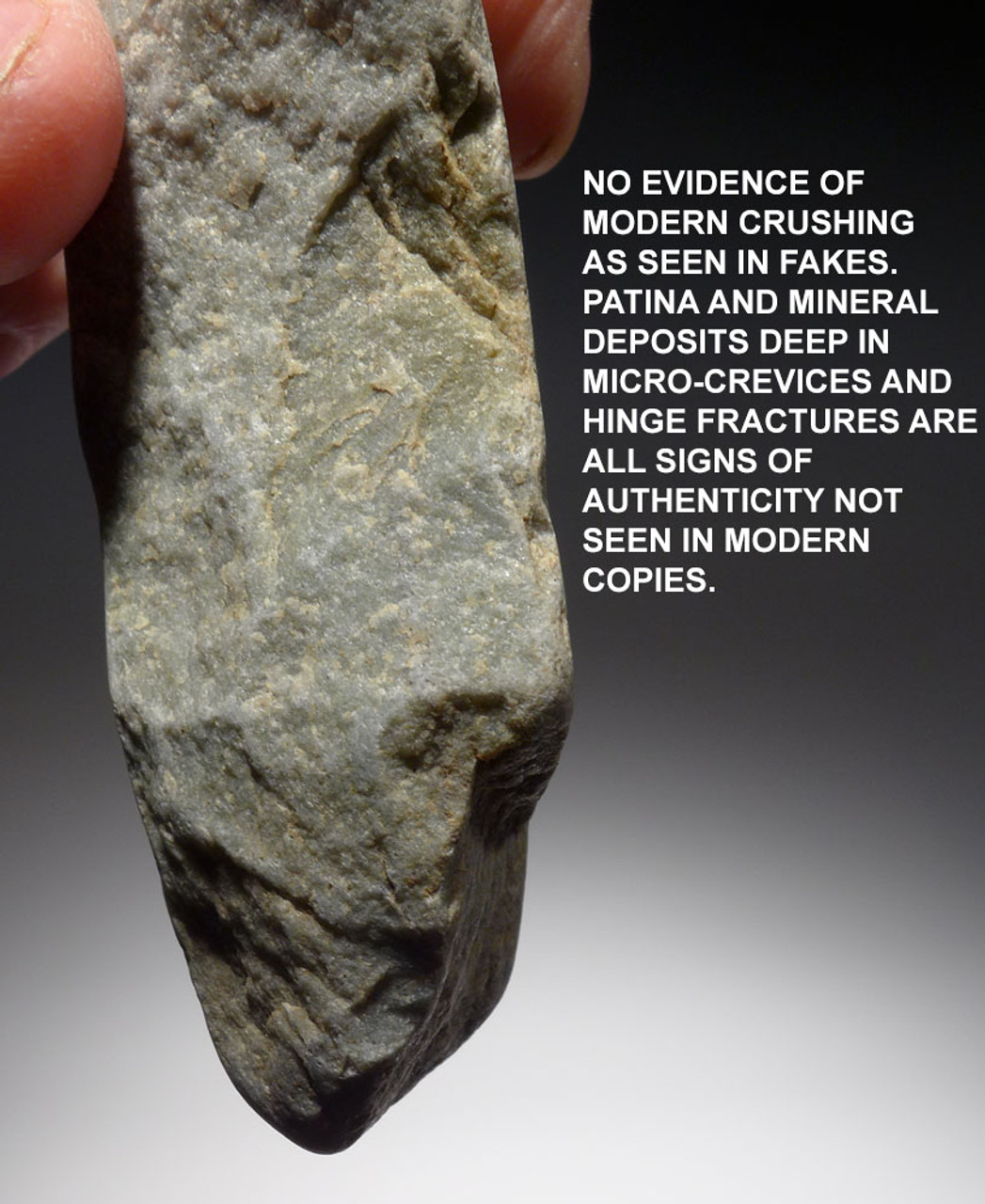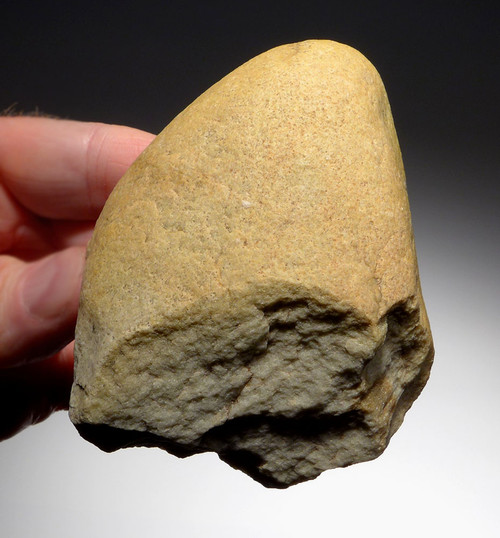Product Description
This is a RARE and fantastic artifact of prehistoric human thought evolution. It was found in a region where some amazing recent discoveries have been made of the earliest human inhabitants in Europe. This pebble axe is from the European Lower Paleolithic Period and a proto hand axe of the late Oldowan tool technology where chopper axes were made on simplistic round river cobbles with crudely struck chisel edges. Showing a "dawning new design", this hand axe displays a trait that would dominate hand axes for the hundreds of thousands of years to come - A POINTED TIP! The axe has been made on a quartzite river cobble but it has been struck on opposing sides to form a tapered pointed chopping end. Such an axe would have been ideal for puncturing large bones of the prehistoric megafauna of the day, to get to the prized bone marrow. Bone marrow was the most nourishing food of this era and bones of mammoth, bison, rhino and horse, for example, were smashed to extract it. A tool like this would have been ideal for the task.
A perfect artifact to demonstrate evolving prehistoric human thought and design, this is a rare transitional Paleolithic tool. Traits only seen in authentic Paleolithic stone tools are present on this example such as a lack of any modern crushing, and sediment / patina deep in microscopic crevices. Tip is unbroken and intact as originally made. Extensive flaking on the sides is evident, to achieve this narrow tapering point.
HISTORY
The Oldowan pebble tool tradition, named after the Oldowan Gorge in Kenya, East Africa where tools were first described, represent stone tools from the earliest primitive humans. By the time early humans made their way into Europe, PEBBLE TOOL technology had already been superseded by the proliferation of Acheulian bifacial handaxes roughly three quarters of a million years later in Africa! These stone tool manufacturing traditions were brought into Europe by Homo erectus (Homo heidelbergensis) moving north up from Africa. Both Pebble and Acheulian traditions existed for a limited time together at the beginning of human existence in Europe with pebble tool technology eventually giving way to more advanced traditions of core and flake tools.
The prehistory of the Iberian Peninsula begins with the arrival of the first hominins 1.2 million years ago. Early hominin remains have been discovered at a number of sites on the peninsula. Significant evidence of an extended occupation of Iberia by Neanderthal man has also been discovered. Homo sapiens first entered Iberia towards the end of the Paleolithic. For a time Neanderthals and modern humans coexisted until the former were finally driven to extinction. Modern man continued to inhabit the peninsula through the Mesolithic and Neolithic periods.
Many of the best preserved prehistoric remains are in the Atapuerca region, rich with limestone caves that have preserved a million years of human evolution. Among these sites is the cave of Gran Dolina, where six hominin skeletons, dated between 780,000 and 1.2 million years ago, were found in 1994. Experts have debated whether these skeletons belong to the species Homo erectus, Homo heidelbergensis, or a new species called Homo antecessor. In the Gran Dolina, investigators have found evidence of tool use to butcher animals and other hominins, which is likely to constitute the first evidence of cannibalism in a hominin species. Evidence of fire has also been found at the site, suggesting they cooked their meat.
Also in Atapuerca, is the site at Sima de los Huesos, or "Pit of Bones". Excavators have found the remains of 30 hominins dated to about 400,000 years ago. The remains have been tentatively classified as Homo heidelbergensis and may be ancestors of the Neanderthals. No evidence of habitation has been found at the site except for one stone hand-ax, and all of the remains at the site are of young adults or teenagers. The age similarity suggests the remains were not the result of accidents. The seemingly deliberate placement of remains and lack of habitation may mean that the bodies were deliberately interred in the pit as a place of burial, which would make the site the first evidence of hominin burial.
Neanderthals in Europe.
Around 200,000 BC, during the Lower Paleolithic period, Neanderthals first entered the Iberian Peninsula. Around 70,000 BC, during the Middle Paleolithic period the last ice age began and the Neanderthal Mousterian culture was established. The Escoural Cave has evidence of human activity starting in the Middle Paleolithic, with an estimated date of 50,000 years BP. Around 35,000 BC, during the Upper Paleolithic, the Neanderthal Châtelperronian cultural period began. Emanating from Southern France this culture extended into Northern Iberia. This culture continued to exist until around 28,000 BC when Neanderthal man faced extinction, their final refuge has been said to be Gibraltar.
WARNING: There are a host of these "prehistoric tools" for sale on Ebay and other websites where sellers have little to no information and understanding of Lower Paleolithic specimens. Many of these sources offer nothing more than damaged ancient river cobbles caused by environmental action (glacial disturbance, frost damage, etc.) or modern made fakes. Every broken cobblestone found is NOT a human-created Paleolithic tool! The determination of what is man-made and what is an ordinary broken river rock requires a very high level of understanding Paleolithic tool manufacture and technique as well as the experience to be able to differentiate the two and authenticate a genuine stone tool from this culture. Know your source and only deal with well-informed sellers who can help you understand the difference. All purchases should be accompanied by a written UNCONDITIONAL AND LIFETIME guarantee of condition and authenticity, as we provide.
 US DOLLAR
US DOLLAR
 EURO
EURO
 AUSTRALIAN DOLLAR
AUSTRALIAN DOLLAR
 CANADIAN DOLLAR
CANADIAN DOLLAR
 POUND STERLING
POUND STERLING






















